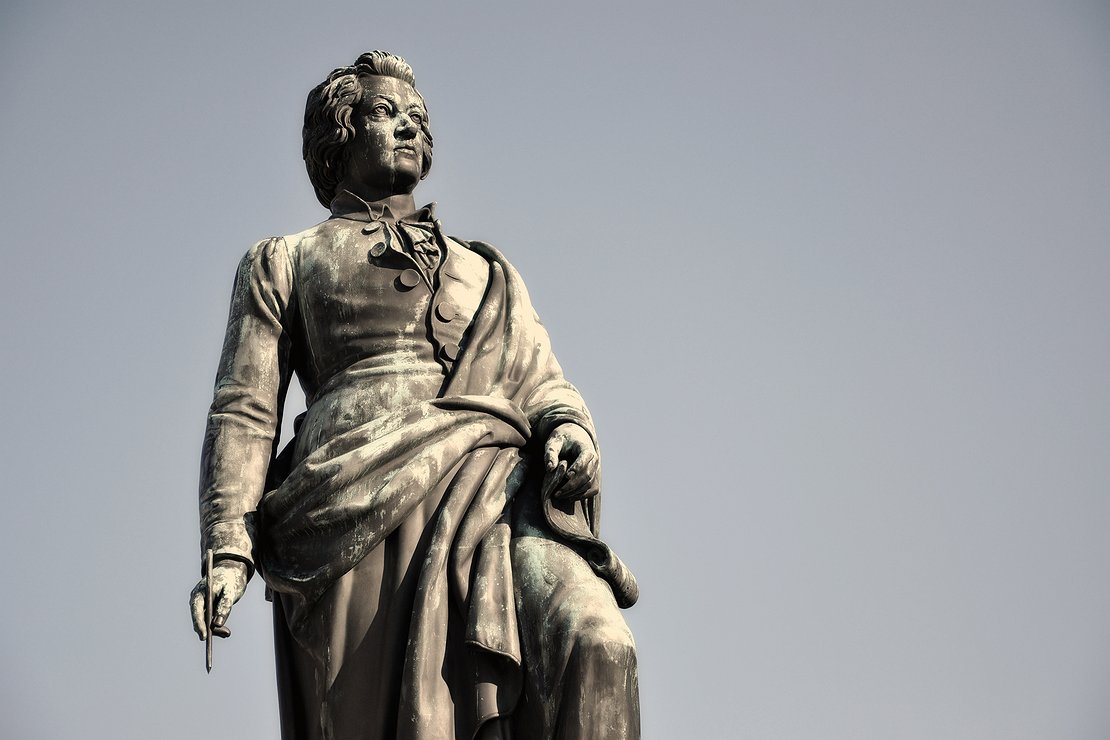
Production of ‘Thamos, King of Egypt’ as scenic narration:One Day in Salzburg’s Mozart Week
For a long time, Salzburg was a little-noticed Upper Austrian district town until artists and tourists discovered the beauty of the city and its surroundings and spread the word about it. Alexander von Humboldt was also here and found the view from the Mönchsberg one of the most beautiful in the world. If you stand on the Humboldt Terrace today, you can understand his dictum, although much of the lovely meadow landscape that the famous German scientist looked across has been built over today. The Alpine panorama is still breath taking.
In the centre of Salzburg stands an expressive statue of Wolfgang Amadeus Mozart, donated by the ‘grateful city.’ When the statue was commissioned, Salzburg was lying pretty much on the ground. Generous donors were needed, and were found all over Austria, although Mozart was not actually Austrian. When he was born, Salzburg was a state in its own right, which Napoleon converted into a secular principality in 1803 and which, after some back and forth, subsequently fell to Austria.
Salzburg can be grateful to its brilliant son, because many of the tourists who visit the city today come because of Mozart. This is particularly true in January, when Mozart's birthday was celebrated for the first time in 1956 on the 27th of that month. The Vienna Philharmonic contributed particularly to the artistic reputation of this festival, playing from the very beginning up to three concerts in that week.
Since June 2017 the Mexican-French tenor with Austrian ancestors Rolando Villazón has been the artistic director. The most drastic decision the new festival director made was to play only Mozart during Mozart Week. His predecessors had also performed music by other composers, as a contrast. According to Villazón in his foreword to the Festival Almanac, Mozart's universal power “brings people together.” His music “is unique for each of us and yet it is the same for all of us.” This is why “in these times when dangerous voices are loudly trying to divide us, this Mozart Week has been developed in Mozart's spirit of participation, togetherness and integration.” One is concentrating on both well-known and rarely performed choral works by Mozart, “above all with a new scenic narration of ‘Thamos, King of Egypt,’ KV 345.”
We were present at the world premiere of this key work at the Felsenreitschule on January 28th and were able to see for ourselves whether the piece lived up to Villazón's claim.
The Catalan troupe La Fura dels Baus performed a modern reworking directed by Carlus Padrissa. A mixture of Mozart's theater music, insert arias, air acrobats, algorithmic music and fireworks was announced.
When the spectators entered the hall of the rock stage, they were greeted by an ‘all-seeing eye,’ which let its colored spotlights circle over the audience in a searching fashion. There was hardly anything to see of the magnificent backdrop of the Felsenreitschule. A glass pyramid hinted at Egypt as the scene of the action, at the same time it was a symbol of all-encompassing power.
Mozart was 17 years old when he wrote the stage music for the play by Tobias Philipp Freiherr von Gebler. The work flopped from the beginning and almost immediately ended up among the ‘discarded pieces.’ Mozart later regretted that he “would not be able to use the music for Thamos.”
So now Carlus Padrissa wanted to breathe new life into the fragment. He put it “in the context of the challenges of the 21st century, which we want to make visible, audible, readable and experienceable through the lens of Antonin Artaud's idea of the ‘organless body’ and the ‘revolutionary body.’ Through the bursting open of constricting physical and artistic paradigms, the isolation of the artist's existence is unbounded into a revolutionary total experience of collective body existence. Only then is art everything - and everything is art.” Those who feared the worst after this gibberish in the Festival Almanac were unfortunately right.
The staging had totalitarian traits in its mass scenes. Bodies robbed of any individuality scurried, crawled, fought each other on stage. The faceless masses preferred by power were reminiscent of scenes from films by Sergei Eisenstein or Fritz Lang. Sometimes they formed into trains that in the specific lighting looked like Ku Klux Klan or medieval monks on their way to the stake for heretics. The air acrobats worked their way through the collapsing walls, or they crawled as Gregor Samsa around the edge of the auditorium.
The texts of the arias were superimposed in and supplemented with contemporary statements about the balefulness of globalization and the destruction of the planet. Sentences from Sarastro's aria which today sound dubious, such as “Whom such teachings does not please, does not deserve to be human” were not placed in their historical context, but overemphasized. For, according to the modern inserted texts, only the enlightened can save the world. One should follow and obey these enlightened ones. Likewise with the demand of the Choir of Priests: “Soon he will be completely devoted to our ministries, his spirit bold, his heart pure, soon he will be worthy of us.”
This problematic image of man, which has little to do with the Enlightenment, is not historically contextualized, but positively underscored. When ‘Thamos’ ends, when the benevolent monarch, who no longer knows wars, allows the sun of freedom to shine, the end of history is achieved.
The final chorus ‘You Children of Dust’ emphasizes: “To labor for the gods, whatever their counsel desires, be our endeavor." This is how subjects sing, not free citizens.
Padrissa's attempt to make the Thamos fragments a 21st century success can confidently be regarded as a failure. The production should rapidly join the ‘discarded pieces.’
But Mozart's music is unruinable. He himself stated: “Thamos” “should only be performed for the sake of the music – and that will hardly be possible; it is certainly a pity!”
To this can only be added, that for the sake of the music, a new attempt should be made to bring the ‘Thamos’ to the stage.
Translated from eigentümlich frei, where the original article was published on February 3rd 2019.




